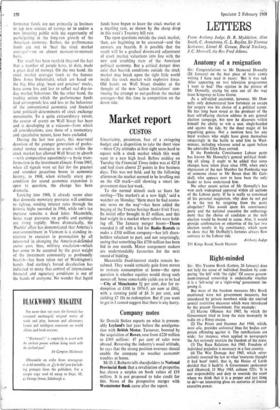Wall St. bubble
FINANCE USA WILLIAM JANEWAY
Wall Street is in trouble. It is a rule of thumb that uncertainty spells trouble for any market, and Wall Street has certainly had a surfeit of uncertainty during the past year. The course of interest rates and the fate of LBJ'S proposed tax increase, the unlikely conjunction of a major war, vicious inflationary pressures on the cost side of industry, and a 'mini-recession' in activity; sterling devaluation and the threat of rising economic nationalism; war overseas and riots at home—altogether there have been more than sufficient grounds for the exercise of more than normal prudence in the gauging of investment prospects.
But the major trends on the New York finan- cial markets during 1968 will not only reflect a gathering consensus as to the answers to 1967's threateningly open questions. What is involved, as well, is a basic structural and psychological characteristic of the 'new' Wall Street. This is the institution of speculation in the shape of what are termed the 'performance' mutual funds (American parlance for unit trusts).
Despite the trauma of 1929-32, the twentieth century has witnessed the sustained growth of the American mutual funds industry, a major institutional channel for mobilising private savings to finance American industry. What is new in the last decade has been the appearance of financial institutions legally endowed with virtually all the freedom of the individual speculator—and generally managed by younger men with the will to make use of that freedom. Unlike the old-established institutions, the per- formance funds are not primarily in business to tap new sources of savings or to endow a new investing public with the opportunity of participating in the long-run growth of the American economy. Rather, the performance funds are out to 'beat the stock market averagcs'—on an almost moment-to-moment basis.
The result has been twofold (beyond the fact that a number of people have, to date, made a great deal of money). On the one hand, the stock market averages (such as the famous Dow Jones Industrials), which are based on the big, blue chip, `meat and potatoes' stocks, have come less and less to reflect real day-to- day market behaviour. On the other hand, the trading action which the performance funds lead corresponds less and less to the behaviour of the conventional economic and financial (and political) determinants of stock exchange movements. To a quite extraordinary extent, the course of events on Wall Street has been and is developing in a vacuum—from which all considerations, save those of a momentary and speculative nature, have been excluded.
During the last two years, this near-total devotion of the younger generation of profes- sional money managers to events within the stock market has allowed Wall Street to absorb —with comparative equanimity—a basic trans- formation in the investment climate. From 1965, when all signals were set fair for the greatest and soundest peacetime boom in economic history, to 1968, when virtually every. pre- condition for sound economic expansion is open to question, the change has been dramatic.
Looking into 1968, it already seems clear that domestic monetary pressures will continue to tighten, sending interest rates through the historic highs recorded in 1966, while un's tax increase remains a dead letter. Meanwhile, fierce wage pressures on profits and earnings are rising rapidly. More dramatically, the 'Pueblo' affair has demonstrated that Anierica's over-commitment in Vietnam is a standing in- vitation to exercises in provocation by all interested in changing the American-deiended status quo; thus, military escalation—which has come to be accepted by the great weight of the investment community as profoundly bearish—has been taken out of Washington's hands. And sterling's forced devaluation has indicated to many that control of international financial and mpnetary conditions is out of the hands of everyone. No wonder that liquid funds have begun to leave the stock market at a startling rate, as shown by the sharp drop in this week's Treasury bill rate.
The open questions outside the stock market, then, are beginning to be answered—and the answers are bearish. It is possible that the result will be a gradual downward adjustment of stock market valuations into line with the new and troubling state of the American political economy. But a critical danger does exist that bearish conditions outside the stock market may break upon the tight little world inside the stock market with explosive force.' Old hands on Wall Street shudder at the thought of the new 'action institutions' con- tinuing the attempt to out-perform the market averages—but this time in competition on the down side.



































 Previous page
Previous page